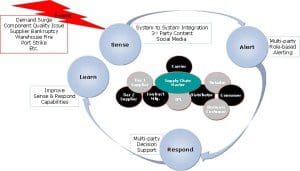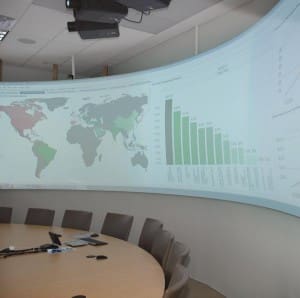On Friday JDA Software announced that it received $570 million in additional equity funding. This made me think about their product roadmap. In particular, would this change their roadmap for supply chain visibility? I hope if anything it enhances it.
Supply chain visibility has become hot, as multinationals again begin to explore supply chain control towers. For JDA, not unexpectedly, much of the initial roadmap for visibility has been focused on their transportation management system (TMS) solution because ensuring on time shipments makes visibility particularly critical to this application. Their vision is to become a “Hub of Hubs” type visibility platform.
Public cloud B2B solutions have special advantages when it comes to supply chain visibility. These solutions offer a large preexisting network of companies already connected to the platform, which means key supply chain partners are apt to find it easier to provide visibility to each other. And these solutions offer a record of marketplace transactions that greatly reduces “he said, she said” type arguments surrounding transportation contracts.
The problem is that no one B2B marketplace offers robust visibility across all modes of transportation and industries. That is why JDA needs to find strong partners in order to be able to provide “hub of hub” visibility. In conjunction with their big user conference in March – JDA Focus – JDA announced three partnerships in this area: INTTRA, FourKites, and TransVoyant.
INTTRA I knew. INTTRA offers Ocean visibility based on EDI messaging, with the visibility to the ever changing sailing schedules of Ocean carriers being particularly important.
FourKites was new to me. I reached out to FourKites and their CEO – Matt Elenjickal – was kind enough to talk to me. EDI is a far from a perfect mechanism to track shipments. For truck tracking purposes, real-time GPS data is much better. The FourKites cloud-based solution connects to feeds from more than 40 GPS device manufacturers whose devices are widely used in the trucking and intermodal industry. FourKites also has access to traffic data. The idea is that real-time data from GPS tracking will be combined with traffic data and with JDA TMS load plan data to allow for much better ongoing reoptimization of transportation plans. So for example, if something is causing huge traffic jams in Kansas City, the FourKites/JDA integration will allow new estimated times of arrivals to be calculated for trucks stuck in that traffic and new routes to be generated for trucks that have not yet arrived in that metropolitan area.
I also knew nothing about TransVoyant, but was able to have a conversation with Dennis Groseclose, TransVoyant’s CEO, about their solution. TransVoyant also makes use of real-time data for tracking of ships and planes. The company combines current and historical data streams with predictive analytics to forecast whether a particular shipment will arrive on time if the goods are shipped from a particular port or airport or cross a border at a particular border crossing. I also managed to talk to one of TransVoyant’s customers who confirmed robust Air tracking capabilities. This customer said they have not finished the testing surrounding Ocean visibility, but suspects it will also be very good. TransVoyant’s capabilities in the predictive analytics area have been strengthened by the ongoing work they are doing with intelligence agencies “to analyze, predict, respond to, and prevent both natural and man-made threats.”
While each of these partnerships has a very specific function that aligns with JDA’s TMS solution, the JDA/TransVoyant partnership is particularly important to JDA. TransVoyant will become a key part of the JDA platform because of their ability to take large data streams and analyze that data within a rules framework that allows for new insights to be discovered. While much of JDA’s initial work is based on using new visibility streams to improve transportation optimization, in the longer term they want to use new streams of data – like social and weather data – to improve demand-supply balancing. TransVoyant may have a big role to play here.
The phrase “in-line” has become common in describing a particular feature of analytics solutions. “In-line analytics” display a metric that is meaningful during a particular step in a multistep process. Critical to the JDA visibility enhancements will be JDA’s robust set of APIs and existing ability to import external content and build robust in-line capabilities. For example, JDA has 300 plus APIs just to support their TMS solutions. JDA customers, for example, that have subscribed to Chainalytics’ transportation lane benchmarking data can already use one of those preexisting APIs to punch out to the Chainalytics’ content, pull it into a transportation planner’s user interface, and have the relevant data be displayed at just the right point in a tendering process.
In conclusion, JDA’s focus on in-line optimization is interesting. “In-line optimization” applies that same in-line concept widely used in analytics to optimization. Their platform will reach out and grab pertinent event, risk, and predictive data and bring it back to their optimization engines to allow for ongoing replanning when unexpected events have led to degradation of the initial plan. But JDA is not interested in visibility for the sake of visibility. Their new capabilities must provide tangible and realistic enhancements to their existing applications.






















